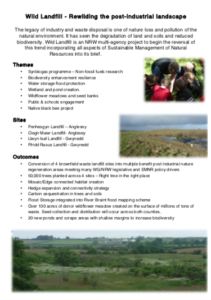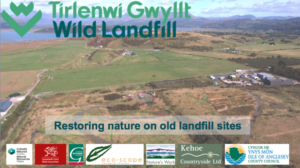Create a Habitat – Lesson Plan KS3/4
A project created by Wild Landfill
Download this lesson plan here

A Wild landfill restorative site
Learning objectives:
By the end of this lesson;
- All students will be able to understand the relationship between organisms in an ecosystem
- Most students will be able to create a food web
- Some students will be able to design a habitat map
Curriculum links at KS3 & 4
| GCSE Geography WJEC
Unit 2: Environmental & Development Issues
Unit 3: Fieldwork Enquiry
|
GCSE Biology WJEC
Unit 1: Ecosystems
Unit 2: Variation
|
KS3 Geography
|
KS3 Biology
|
Checklist of learning: Pupils complete this checklist of terms at the start and end of the lesson to monitor learning and progress.
Background: Wild Landfill – Creating habitats in the post-industrial landscape
The legacy of industry and waste disposal is one of loss of nature and pollution of the natural environment. It has seen the degradation of land and soils and reduced biodiversity. Led by NRW in Partnership with Gwynedd and Ynys Mon County Councils, Wild Landfill is the Welsh Government’s Challenge Fund rewilding initiative restoring North Wales landfill sites into thriving, biodiverse, natural habitats. The project aims to begin the reversal of this trend incorporating all aspects of sustainable management of natural resources into its brief. Among the major themes of this project are to; increase biodiversity, provide water storage and flood protection, create wetlands, ponds, wildflower meadows and woodland.
Four brownfield waste landfill sites across Gwynedd and Ynys Mon will be regenerated into a mosaic of wildlife habitats which will not only be new homes for nature but will begin to store carbon. Initiatives include the planting of more than 45,000 new trees and creating over 100 acres of new wildflower meadow.
Starter activity:
Matched pairs – Also acts as a list of keywords with definitions.
Activity:
- Step 1: Create a habitat key for the landfill site. Label the zones on the map.
- Step 2: Match plant and animal species to each habitat
- Step 3: Add the arrows to the energy flow diagram
- Step 4: Create one food chain of 3 or 4 species for one habitat
- Step 5: Add a top predator (tertiary consumer) to the food chain
- Step 6: Create a food web for the site as a whole
Resources for the above activity:
- Species cards
- Habitat cards
- Blank landfill site habitat map for Llwyn isaf
- Blank landfill site habitat map for Penhesgyn
- Background maps and images for habitat creation activity – Llwyn Isaf
- Background maps and images for habitat creation activity – Penhesgyn
Presentation: Use this presentation on the landfill project as part of a lesson on habitats and ecosystems.
Plenary activity:
Bingo cards. Print out and distribute the bingo cards (9 different combinations). Print out and cut up the keywords. Draw from a hat! Call out each word and students aim to get a line or full house. Develop their knowledge and understanding by asking for definitions or examples when a keyword is drawn out.
Pledge:
![]() Create a promise to put into action. Students write these on a postcard and these will be kept and returned after 3 months. They are designed to inspire, empower and reward young people. Share via social media. https://www.instagram.com/wildlandfill/
Create a promise to put into action. Students write these on a postcard and these will be kept and returned after 3 months. They are designed to inspire, empower and reward young people. Share via social media. https://www.instagram.com/wildlandfill/
Plenary: Watch the story How wolves change rivers. This is a plenary activity where the pupils can engage with a real ecological and rewilding project.



